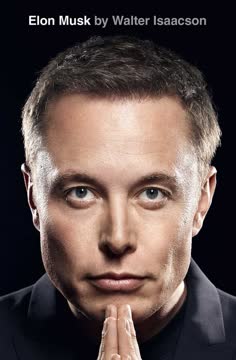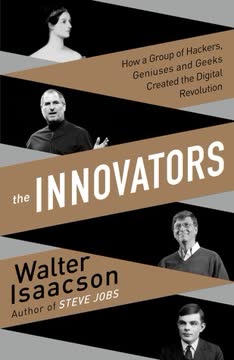Key Takeaways
1. Embrace innovation and adapt to change for business success
"If it were possible to establish conditions where persons could become united with a firm spirit of teamwork and exercise to their hearts' desire their technological capacity, then such an organization could bring untold pleasure and untold benefits."
Innovation is key. Sony's success stems from its commitment to creating new products and technologies that enhance people's lives. The company consistently pushed boundaries, from developing the world's first transistor radio to pioneering the Walkman and digital cameras.
Adaptability ensures survival. In a rapidly changing technological landscape, companies must be willing to evolve and sometimes cannibalize their own products. Sony's transition from analog to digital technology and its continuous reinvention of consumer electronics exemplify this principle.
- Examples of Sony's innovations:
- Transistor radio
- Trinitron color TV
- Walkman
- Compact Disc
- PlayStation
2. Prioritize quality and customer satisfaction over short-term profits
"To have any one of these without the others is self-defeating in business."
Quality is paramount. Sony's commitment to producing high-quality products, even at the expense of short-term profits, helped establish its reputation as a premium brand. This philosophy extended from product design to manufacturing processes and customer service.
Customer-centric approach. By focusing on creating products that genuinely improve people's lives and experiences, Sony built a loyal customer base. The company's emphasis on user experience and product reliability contributed significantly to its long-term success and brand value.
- Key aspects of Sony's quality focus:
- Rigorous quality control in manufacturing
- Continuous improvement of products
- Investment in after-sales service
- User-centered design philosophy
3. Foster a company culture that values employees as family
"The most important mission for a Japanese manager is to develop a healthy relationship with his employees, to create a family-like feeling within the corporation, a feeling that employees and managers share the same fate."
Employee loyalty. Sony cultivated a sense of belonging among its employees, treating them as valuable members of the corporate family. This approach fostered loyalty, creativity, and dedication to the company's goals.
Long-term perspective. By investing in employee development and maintaining a commitment to long-term employment, Sony created a stable workforce capable of sustained innovation and growth. This contrasts with the more transient employment culture often seen in Western companies.
- Elements of Sony's employee-centric culture:
- Lifetime employment philosophy
- Continuous training and skill development
- Open communication between management and employees
- Shared sense of purpose and company vision
4. Leverage technology for survival and competitive advantage
"We Japanese feel that all things are provided as a sacred trust and actually are only loaned to us to make the best use of. To waste something is considered a kind of sin."
Technological prowess. Sony's success was built on its ability to harness and develop cutting-edge technologies. From transistors to digital imaging, the company consistently pushed the boundaries of what was possible in consumer electronics.
Efficiency and sustainability. The Japanese concept of "mottainai" (avoiding waste) influenced Sony's approach to resource management and product design. This philosophy led to more efficient manufacturing processes and environmentally conscious products.
- Key technological advancements by Sony:
- Miniaturization of electronics
- Digital audio and video technologies
- Energy-efficient product designs
- Recycling and sustainable manufacturing practices
5. Cultivate a global perspective while maintaining cultural identity
"I believe it is a big mistake to think that money is the only way to compensate a person for his work. People need money, but they also want to be happy in their work and proud of it."
Global expansion. Sony's success in international markets was driven by its ability to adapt to local cultures while maintaining its core Japanese values. This balance allowed the company to become a truly global brand.
Cultural exchange. By encouraging international experiences for its employees and embracing diverse perspectives, Sony fostered innovation and improved its ability to serve global markets. This approach helped bridge cultural gaps and create products with universal appeal.
- Strategies for global success:
- Localization of products for different markets
- International management teams
- Cross-cultural training for employees
- Establishment of overseas research and development centers
6. Balance competition and cooperation in the business world
"The glory and the nemesis of Japanese business, the life's blood of our industrial engine, is good old-fashioned competition."
Fierce competition. Sony thrived in Japan's highly competitive business environment, which drove constant innovation and improvement. This domestic competition prepared Japanese companies for success in global markets.
Strategic cooperation. While competing fiercely, Sony also recognized the value of strategic partnerships and industry cooperation. This balanced approach allowed for shared technological advancements and industry standards, benefiting both companies and consumers.
- Examples of competition and cooperation:
- Intense rivalry in consumer electronics market
- Collaborative efforts in developing industry standards (e.g., Compact Disc with Philips)
- Joint ventures and technology sharing agreements
- Participation in industry associations and trade groups
7. Invest in research and development for long-term growth
"We have poured billions into our technical laboratories for R&D, and others have watched us and taken advantage of our up-front investment by moving into our field after we have pioneered it, but we cannot change this."
Commitment to R&D. Sony's substantial investment in research and development was crucial to its long-term success. This commitment allowed the company to stay at the forefront of technological innovation and create new market opportunities.
Balancing research and commercialization. While investing heavily in R&D, Sony also focused on turning research into marketable products. This balance between pure research and practical application was key to the company's sustained growth and profitability.
- Key aspects of Sony's R&D strategy:
- Dedicated research facilities (e.g., Sony Computer Science Laboratories)
- Collaboration with universities and research institutions
- Regular technology exchange conventions within the company
- Emphasis on both basic and applied research
8. Manage resources efficiently and practice sustainability
"We Japanese are obsessed with survival. Every day, literally, the earth beneath our feet trembles."
Resource conservation. Japan's limited natural resources instilled a deep sense of conservation and efficiency in its people and businesses. Sony applied this mindset to its operations, minimizing waste and maximizing resource utilization.
Sustainable practices. The company's commitment to sustainability extended beyond resource management to include environmentally friendly product design and manufacturing processes. This approach not only reduced costs but also appealed to increasingly environmentally conscious consumers.
- Sony's sustainability initiatives:
- Energy-efficient product designs
- Recycling programs for electronic waste
- Reduction of packaging materials
- Development of alternative energy technologies
9. Navigate international trade relationships with diplomacy and understanding
"I have always advocated the idea of more personal contacts among top business executives from around the world."
Building relationships. Morita emphasized the importance of personal relationships and cultural understanding in international business. His efforts to bridge cultural gaps between Japan and the West helped pave the way for Sony's global success.
Addressing trade tensions. As Japan's economic power grew, so did trade tensions with other countries. Sony played a role in navigating these challenges, advocating for open markets and fair competition while also addressing concerns about Japan's trade practices.
- Strategies for international business relations:
- Regular meetings between business leaders from different countries
- Cultural exchange programs for employees
- Participation in international trade associations
- Transparent communication about business practices and intentions
10. Learn from failures and persist in the face of challenges
"I always tell employees that they should not worry too much about what their superiors tell them. I say, 'Go ahead without waiting for instructions.'"
Embracing failure. Sony's culture encouraged risk-taking and learning from failures. This approach allowed the company to innovate rapidly and recover quickly from setbacks.
Persistence and adaptability. Throughout its history, Sony faced numerous challenges, from postwar reconstruction to intense global competition. The company's ability to persevere and adapt to changing circumstances was crucial to its long-term success.
- Lessons from Sony's challenges:
- The Betamax vs. VHS format war
- Transition from analog to digital technologies
- Adapting to changing consumer preferences
- Recovering from natural disasters and economic crises
Last updated:
FAQ
What's Made in Japan: Akio Morita and Sony about?
- Personal Journey: The book chronicles Akio Morita's life, from his childhood to co-founding Sony Corporation, highlighting his personal and professional growth.
- Post-War Japan: It provides insights into Japan's recovery after World War II, focusing on the challenges and opportunities during this transformative period.
- Business Philosophy: Morita shares his management philosophy, emphasizing innovation, teamwork, and a family-like corporate culture.
- Cultural Insights: The book contrasts Japanese and American business practices, advocating for a collaborative and less hierarchical approach.
Why should I read Made in Japan: Akio Morita and Sony?
- Inspiration from a Pioneer: Gain insights from one of the most influential figures in the electronics industry, learning from Morita's experiences and lessons.
- Understanding Global Business: The book offers a perspective on how Japanese companies operate globally, crucial for understanding international business dynamics.
- Management Strategies: Morita shares practical strategies, emphasizing employee welfare and long-term planning, relevant in today’s fast-paced business environment.
What are the key takeaways of Made in Japan: Akio Morita and Sony?
- Value of Teamwork: Morita stresses the importance of developing healthy relationships with employees, fostering a sense of shared fate.
- Innovation is Crucial: Continuous innovation is necessary, with a focus on teamwork and technological capacity to bring benefits and pleasure.
- Long-Term Vision: Businesses should focus on long-term growth rather than short-term profits, investing in research and development for sustained success.
What are the best quotes from Made in Japan: Akio Morita and Sony and what do they mean?
- “The road of a pioneer is full of difficulties.”: Reflects the challenges faced by innovators, emphasizing perseverance for success.
- “Happiness must be created yourself.”: Highlights the responsibility of individuals to create their own happiness, crucial for fulfillment.
- “Profit doesn’t have to be so high.”: Prioritizes long-term growth over immediate financial gains, underscoring sustainable business practices.
What management style does Akio Morita advocate in Made in Japan: Akio Morita and Sony?
- Family-Like Corporate Culture: Morita promotes a family-like atmosphere, where employees feel valued and connected to the organization’s success.
- Consensus Building: He believes in building consensus among management and employees, encouraging collaboration and innovation.
- Focus on Employee Welfare: Prioritizing job security and welfare, especially during economic downturns, leads to a motivated workforce.
How did Akio Morita view competition in Made in Japan: Akio Morita and Sony?
- Competition as a Catalyst: Morita sees competition as essential for innovation and improvement, pushing companies to enhance their offerings.
- Learning from Rivals: Observing and learning from competitors can lead to better products and services, improving market quality.
- Avoiding Destructive Practices: He warns against cutthroat competition, advocating for fair practices that respect industry integrity.
What challenges did Sony face in its early years according to Made in Japan: Akio Morita and Sony?
- Market Acceptance: Sony struggled to gain acceptance for innovative products, like the transistor radio, as consumers were unfamiliar with new technology.
- Financial Constraints: The company faced financial difficulties, often relying on loans and investor support for operations and development.
- Competition from Established Brands: Competing against larger, established companies made it difficult for Sony to carve out a niche.
How did Akio Morita adapt to the American business environment in Made in Japan: Akio Morita and Sony?
- Embracing Direct Communication: Morita learned to navigate the direct communication style in American business, contrasting with Japanese hierarchy.
- Building Relationships: He focused on establishing personal relationships with American partners, understanding the importance of trust.
- Learning from Mistakes: Morita was open to learning from experiences and mistakes, adapting strategies based on feedback and conditions.
What innovations did Sony introduce as described in Made in Japan: Akio Morita and Sony?
- Transistor Radio: Sony was among the first to produce a compact transistor radio, revolutionizing portable music consumption.
- Walkman: The Walkman changed personal music listening, becoming a cultural phenomenon with its portability.
- Trinitron Technology: Sony developed the Trinitron color television system, setting a standard in the industry with superior picture quality.
How does Made in Japan: Akio Morita and Sony address the concept of failure in business?
- Learning from Mistakes: Morita emphasizes that mistakes are natural, advocating for learning from them and avoiding repetition.
- Encouraging Risk-Taking: A culture that encourages risk-taking and innovation is crucial, understanding that not every idea will succeed.
- Focus on Improvement: Analyzing failures to improve processes and products fosters a mindset of continuous improvement.
How does Morita address the concept of mottainai in Made in Japan: Akio Morita and Sony?
- Cultural Significance: Mottainai reflects respect for resources and minimizing waste, influencing Japanese business practices.
- Practical Application: Encourages efficiency and resourcefulness, urging companies to make the most of resources and avoid waste.
- Long-Term Sustainability: Connects mottainai to long-term sustainability, ensuring longevity and success by valuing resources.
What is the significance of the Walkman in Made in Japan: Akio Morita and Sony?
- Cultural Impact: The Walkman revolutionized music consumption, making it portable and personal, enhancing the listening experience.
- Market Strategy: Emphasized educating consumers about its benefits, creating a strong brand image to differentiate from competitors.
- Innovation and Design: Exemplifies Sony's commitment to innovation and design excellence, combining technology with user-friendly design.
Review Summary
Made in Japan is highly praised for its insights into Sony's founding, Japanese business culture, and post-WWII Japan's economic rise. Readers appreciate Morita's entrepreneurial spirit, management philosophy, and global perspective. The book offers valuable lessons on innovation, leadership, and international trade. Many find parallels between Morita and Steve Jobs. While some criticize the later chapters for being outdated or self-congratulatory, most reviewers consider it an essential read for understanding Japanese business practices and Sony's success story.
Similar Books










Download PDF
Download EPUB
.epub digital book format is ideal for reading ebooks on phones, tablets, and e-readers.




